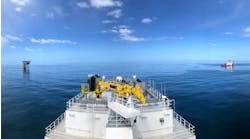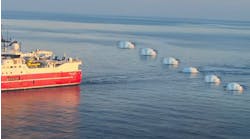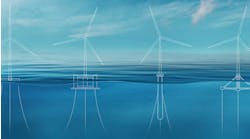India's offshore discovery, first by an outside company for many years, off Gujarat province, could force major operators to reassess the country's exploration potential. Until now, India has been viewed largely in downstream terms as a market for gas imports from neigh-boring nations.
The new find, called Lakshmi, flowed substantial quantities of gas and is conveniently situated close to existing pipelines and a host of planned LNG terminals. The well was operated by Edinburgh, UK-based independent Cairn Energy, which also drew attention to Bangladesh in the late 1990s with its Sangu offshore gas discovery.
Operator- ship of Sangu has passed to joint venture partner Shell, leaving Cairn free to commit resources to its growing interests around India. These include two exploration blocks, (partly deepwater acreage) situated in the Krishna Ghodavari Basin off the east coast, south of the producing Ravva oil and gas field.
Lakshmi was Cairn's first commitment well as 75% operator of block CB-OS/2 in the Cambay Basin - its partners are TATA Petrodyne with 15% and ONGC with 10%, although the latter's stake could rise to 30% if the find proves commercial. The announcement stated that multiple payzones had been encountered between 760 and 1,270 meters, with TD set at 1,350 meters. Due to the imminent approach of the monsoon season, testing was by necessity limited. However, a total of 30 meters gross interval was perforated at 805-860 meters, with the well flowing 28 MMcf/d of dry methane gas at a wellhead pressure of 735 psi. Oil samples were also recovered by RFT from two zones deeper in the well.
Two appraisals planned
Reservoir potential will be appraised this October, when the partners plan to drill two appraisal wells as well as further exploration wells. The water depth in this area is very shallow, typically around 20 meters. Other prospects have been identified in CB-0S/2, which have similar characteristics to Lakshmi.
The new discovery is situated between the undeveloped North Tapti Field to the west and the Hazira Field to the east, where 1.5 tcf is being developed by Niko Resources and Gujarat State Petroleum Co. North Tapti, operated by ONGC. These discoveries are thought to contain 1-1.5 tcf of gas. Both are ring-fenced within CB-0S/2. In adjoining waters to the southeast are the Mid/South Tapti gas discoveries, estimated to contain 3.5 tcf, according to operator Enron.
Gujarat state is heavily industrialized, so there are numerous potential customers for the CB-0S/2 gas. Cairn has already held talks with a number of potential buyers. Local LNG schemes are either being implemented or planned by Enron, BG Gujarat, TotalFinaElf, and Shell/Essar.
According to Cairn's Chief Executive Bill Gemmell, India's Petroleum Minister would like the gas commercialized as soon as possible. Gemmell also pointed out that cooperation with ONGC and the authorities in Gujarat allowed the well to be drilled only two months after seismic acquisition in the block this February. This suggests that India's internal procedural reforms are finally working.
However, it has taken a while for Cairn to attain its current status. The firm entered India in 1994 after acquiring Command Petroleum, which held a 22.5% operating stake in the Ravva Field in the K-G Basin. Cairn has steadily built up production ever since.
Ravva development
When it first took the reins, Ravva was an 80 million bbl oil field, producing 3,000 b/d. By reprocessing old seismic, putting in new platforms and drilling 13 new wells, output now stands at 50,000 b/d of oil and 25 MMcf/d of gas, and the field's oil reserves have been upgraded to 250 million boe.
The Ravva Joint Venture recently sought government approval to develop non-associated gas from satellite fields in the Ravva Contract Area, for sale to national utility, GAIL. In anticipation, a 310-sq-km 3D seismic survey was commissioned over the entire contract area, with a view to drilling identified prospects in 2001.
Ravva's potential, however, is offset by the current PSC terms. Increased production and higher oil prices are benefiting the government somewhat more than the joint venture. There is little incentive, therefore, under the current terms to take development a stage further.
In any case, Cairn plans to spend up to $100 million on its various offshore and onshore concessions between 2000-2001. These include the 6,090 sq km KG-0S/6 Contract Area (Cairn 50%) adjacent to Ravva. Here, 1,500 km of 2D seismic was acquired last year and is currently being interpreted.
Deepwater blocks
This January, Cairn was also awarded block KG-DWN-98/2, covering 9,800 sq km southeast of Ravva. This was one of the deepwater blocks offered under last year's New Exploration Licensing Round, which lacked participation by most of the majors (unfortunately for India, the timing coincided with the prolonged oil price slump). Water depths range from 300 meters in the north to 3,000 meters in the south. Four wells have been drilled in the northern sector by ONGC in the 1970s, two of which flowed oil and gas on test.
A 3D seismic acquisition program over the northern part of the block is nearing completion, and Cairn plans to start exploration drilling before the end of this year. In addition, 2D seismic will be commissioned over the deeper water areas to delineate longer-term exploration targets.
Software confirms Ravva potential
In mid-1998, Cairn Energy India began evaluating the feasibility of doubling production from the Ravva Field through the existing infrastructure. Edinburgh Petroleum Services was requested to develop and install a FloSystem (EPS proprietary software package for well production and field network modeling) model of the field, and to use this model to investigate the performance of the field for various potential production scenarios. WellFlo models of 16 producing strings were constructed and tuned to match the most recently available production data.
These well models were then incorporated into a FieldFlo network model of the field. The model was tuned to match total field oil production to within +/-35%, which is well within the tolerance considered acceptable. Generally, this match was achieved with reasonable errors in the wellhead and manifold pressures (compared with reported data). The tuned model was then used to predict field performance for four production scenarios selected by Cairn, where the effects of declining reservoir pressure and increasing water cut were considered. With the exception of one well (A), for all four cases, the model predicted that the target for each well could be achieved. Major bottlenecks in the system were identified as well as flowlines possessing a high pressure drop at the increased production rates.
The results of this study and the working field model were delivered to Cairn at its Chennai headquarters. At the same time, Cairn production engineers were also trained to build, run and maintain the well network models. The result has been that more than one year after delivery, the model is still being used regularly to monitor field production and diagnose potential well problems or pipeline bottlenecks.


